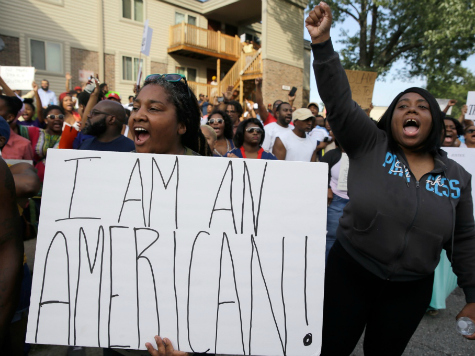
After Michael Brown’s death, left-wing activists, pundits, and the mainstream press have been blasting and maligning Ferguson’s “white power structure,” likening the city to a town in the Jim Crow South. They have lamented that though the city is nearly 70% black, “five of Ferguson’s six city council members are white” and “six of the local school board’s seven members are white.” Ferguson’s mayor, James Knowles, is also white. Even worse to the mainstream press and left-wing activists is that he’s a Republican.
But in trying to further the narrative that the “white power structure” was somehow imposed on Ferguson’s black residents, few have overtly made the point that Ferguson’s black residents could have easily voted out these officials. And they did not. Knowles, who was first elected in 2011, actually ran unopposed in 2013.
According to an MSNBC report, local African-American leaders conceded that “blacks across the region simply haven’t participated in city elections.” They are right. According to a Washington Post analysis, an estimated 6% of blacks and 17% of whites turned out for the 2013 municipal elections in the township, which are held in spring in odd-numbered years. In contrast, during the 2012 presidential election, 54% of blacks and 55% of whites turned out in November.
In the 2011 mayoral election, Knowles was first elected with 46% of the vote. He got 695 votes, Pearce Neikirk received 459, and incumbent Steven Wegert received 338. The New York Times noted that Knowles even “noted his disappointment with the turnout – about 12 percent – in the most recent mayoral election during a City Council meeting in April.” Left-wing activists have asserted that since turnout is lower in odd-numbered years, Ferguson’s elections perpetuate the “white power structure.”
But according to the Washington Post, Ferguson is “hardly unique” in holding municipal elections in odd-numbered years; in fact, “approximately three-fourths of American municipalities hold their elections in odd years.” Ferguson’s municipal elections are also nonpartisan, “where party labels do not appear on the ballot,” and the Post claims this reduces “both what citizens know about candidates as well as their likelihood of voting.” Others would argue that it does not ensure that someone gets elected for life by having an “R” or a “D” next to their names on the ballot.
After remarking this week that “there is no racial divide” in Ferguson and the vast majority of Ferguson residents do not have racial animus, like the mainstream media would like Americans to believe, Knowles was ridiculed and slammed. Lizz Brown, a columnist for the St. Louis American, for instance, told Andrea Mitchell on Tuesday that Knowles was “disconnected to the reality of his community” and that black residents “are invisible to him.”
An MSNBC report, though, recently concluded after interviewing residents that “relations between ordinary blacks and whites in Ferguson… are said to be relatively good” while also noting that “like the police force, the city government has come under fire during the current crisis for what many see as a lack of sensitivity to minority concerns.”
Left-wing outlets like ThinkProgress have suggested that Ferguson amend its charter, which can be done “through a ballot initiative initiated by the city’s voters,” to “reschedule its municipal elections so that they are held in November of even-numbered years – the same time that federal elections are held.” Instead of rioting or complaining about the white power structure, ThinkProgress suggests that Ferguson residents “could start collecting signatures now,” which “would allow Ferguson’s residents to vote on the amendment next April, at a time when black turnout is likely to be higher than it usually is due to lingering concerns over the Brown shooting.”
Larry Elder, in a Tuesday appearance on the Laura Ingraham Show, said that if blacks who have been ceaselessly complaining about the “white power structure” after Michael Brown’s death wanted to “change the power structure” in Ferguson they should “get out and vote.” He also noted that it is racist to assume that white people cannot represent blacks. He noted that blacks had been a majority in Compton, California, which is primarily Latino today. Elder noted that Compton’s elected officials are still mostly black and to assume that they cannot represent their Latino constituents just because of the color of their skin is racist.
In 1965, civil rights activists, including Rep. John Lewis (D-GA), were beaten on the Edmund Pettus Bridge on “Bloody Sunday” while marching for voting rights. Nearly 50 years later after their predecessors fought and died for the franchise, black residents in Ferguson, Missouri, have essentially disenfranchised themselves and are responsible for empowering the “white power structure” that they have been complaining about after Brown’s death.

COMMENTS
Please let us know if you're having issues with commenting.